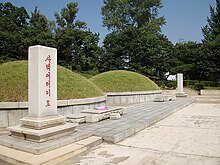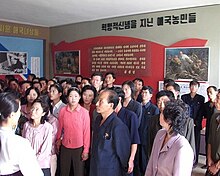Sinchon Museum of American War Atrocities
 The main building of the Sinchon Museum of American War Atrocities | |
| Established | 26 March 1958 |
|---|---|
| Location | North Korea |
| Coordinates | 38°21′17″N 125°29′15″E / 38.35472°N 125.48750°E |
| Type | War museum |
The Sinchon Museum of American War Atrocities (Korean: 신천박물관) is a museum dedicated to the Sinchon Massacre, a massacre of North Korean civilians during the Korean War which the North Korean government claims was carried out by South Korean and US troops. The museum is located in Sinchon County of North Korea.[1] In July 2015, the museum was rebuilt and moved to a new location in the country.[2]
History

The Sinchon Museum of American War Atrocities houses exhibits the deaths of over 35,000 people from October 17 to December 7 in 1950, at the same period of time when the major cities of North Korea, such as Pyongyang (the capital city) and Hamhung, were under wartime occupation by South Korean, American and United Nations military forces.[1]

The South Korean-based Institute for Korean Historical Studies concluded that both Communists and anti-Communist vigilantes engaged in wholesale slaughter throughout the area, and that the 19th Infantry Regiment took the city and failed to prevent the South Korean secret police that came with them from perpetrating the civilian murders; however, the regiment did not participate themselves. Furthermore, when North Korean communists retook the city, the population was again purged.[3][4] Other sources have concluded that the "massacre" was caused by a local rivalry that used the fog of war as a pretense.[5]
Notable visitors
Kim Il Sung visited the museum in 1953 and 1958, as did his son, Kim Jong Il, who paid a visit there in 1962 and 1998.[citation needed]
North Korean leader Kim Jong Un (the son of Kim Jong Il and the grandson of Kim Il Sung) visited the museum along with his sister in 2014.[6]

See also
References
- ^ a b "50th Anniversary of Sinchon Museum Observed". KCNA. Archived from the original on 9 June 2011. Retrieved 13 March 2011.
- ^ Video of the new museum location
- ^ Institute for Korean Historical Studies. 《사진과 그림으로보는 북한현대사》 p91~p93
- ^ The Truth About the Sinchun Massacre Archived 19 June 2013 at the Wayback Machine
- ^ Review: Hwang Sok-yong, The Guest (Seven Stories Press, 2005)
- ^ "'They Are Cannibals': Kim Jong-un Visits North Korea's US War Atrocities Museum". VICE News. 26 November 2014.
